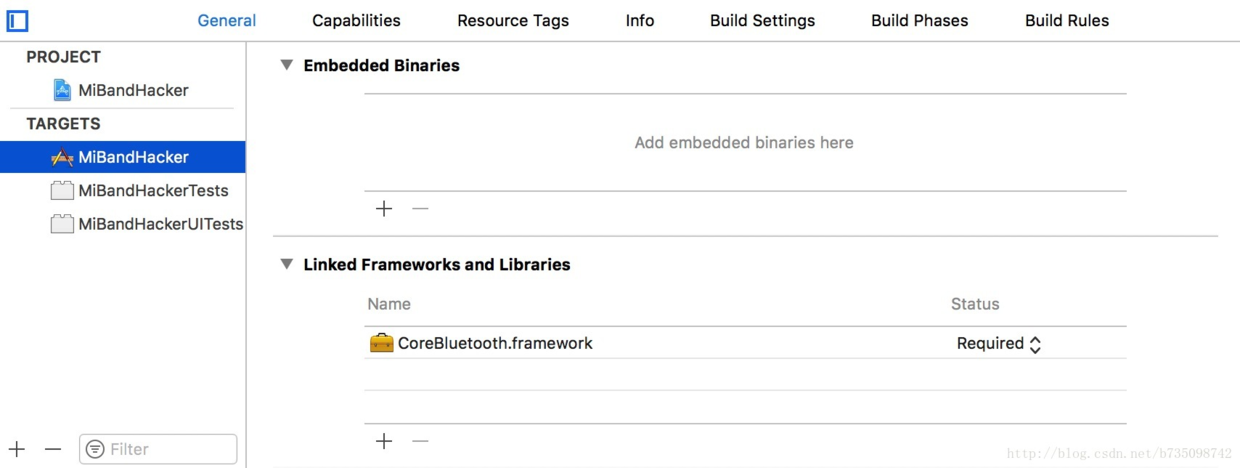上一篇文章我们讲了iOS开发的理论知识,下面我们就从代码开始讲解。
1.CoreBluetooth.framework导入
1.在General->TARGETS->Linked Framworks and Libraries中点击添加并选择CoreBluetooth.framework导入。
 2.在代码中导入CoreBluetooth.framework Swift:import CoreBluetooth Objective-C:#import
2.在代码中导入CoreBluetooth.framework Swift:import CoreBluetooth Objective-C:#import
3.声明协议:使用CoreBluetooth需要支持CBCentralManagerDelegate(需要蓝牙管理者mgr 管理者可以扫描外围设备), CBPeripheralDelegate协议(mgr扫描到外设,与外设进行连接断开连接信息交流等一系列反馈回调),即前面所说的中心设备和外围设备,并实现相应方法
2.建立一个Central Manager实例进行蓝牙管理
self.centralManager = [[CBCentralManager alloc] initWithDelegate:self queue:nil];
一旦设置代理在运行程序的时候,就会调用协议里一个必须要完成的方法:
这个方法是查看中心设备是否打开蓝牙。
#pragma mark - 只要中心管理者初始化 就会触发此代理方法 判断手机蓝牙状态
- (void)centralManagerDidUpdateState:(CBCentralManager *)central
{
switch (central.state)
{
// PoweredOff
case CBCentralManagerStatePoweredOff:
break;
// PoweredOn
case CBCentralManagerStatePoweredOn: //蓝牙已开启
// 搜索外设
[self.centralManager scanForPeripheralsWithServices:nil options:self.centralManagerOptionDic];
break;
// Resetting
case CBCentralManagerStateResetting:
break;
// Unsupported
case CBCentralManagerStateUnsupported: //不支持蓝牙
break;
// Unauthorized
case CBCentralManagerStateUnauthorized:
break;
// Unknown state
case CBCentralManagerStateUnknown:
break;
default:
break;
}
}
[manager scanForPeripheralsWithServices:nil options:nil];
第一个参数那里表示扫描带有相关服务的外部设备,例如填写@[[CBUUIDUUIDWithString:@"需要连接的外部设备的服务的UUID"]],即表示带有需要连接的外部设备的服务的UUID的外部设备,nil表示扫描全部设备;
options处以后细讲,暂时可以写一个@{CBCentralManagerScanOptionAllowDuplicatesKey :@YES}这样的参数,YES表示会让中心设备不断地监听外部设备的消息,NO就是不能。
3.扫描周边的蓝牙设备
// 1.中心管理者 2.外设 3.外设携带的数据 4.外设发出的蓝牙信号强度
- (void)centralManager:(CBCentralManager *)central
didDiscoverPeripheral:(CBPeripheral *)peripheral
advertisementData:(NSDictionary *)advertisementData
RSSI:(NSNumber *)RSSI
{
/*
peripheral = <CBPeripheral: 0x166668f0 identifier = C69010E7-EB75-E078-FFB4-421B4B951341, Name = "OBand-75", state = disconnected>, advertisementData = {
kCBAdvDataChannel = 38;
kCBAdvDataIsConnectable = 1;
kCBAdvDataLocalName = OBand;
kCBAdvDataManufacturerData = <4c69616e 0e060678 a5043853 75>;
kCBAdvDataServiceUUIDs = (
FEE7
);
kCBAdvDataTxPowerLevel = 0;
}, RSSI = -55
*/
if ([peripheral.name hasPrefix:@"OBand"]) {
[self.centralManager stopScan];
// 在此处对我们的 advertisementData(外设携带的广播数据) 进行一些处理
// 标记我们的外设,让他的生命周期 = vc
self.peripheral = peripheral;
// 发现完之后就是进行连接
[self.centralManager connectPeripheral:self.peripheral options:nil];
NSLog(@"%s, line = %d", __FUNCTION__, __LINE__);
}
}
4.连接外围设备
// 中心管理者连接外设成功
- (void)centralManager:(CBCentralManager *)central didConnectPeripheral:(CBPeripheral *)peripheral
{
NSLog(@"%s, line = %d, %@=连接成功", __FUNCTION__, __LINE__, peripheral.name);
// 连接成功之后,可以进行服务和特征的发现
// 设置外设的代理
self.peripheral.delegate = self;
// 外设发现服务,传nil代表不过滤
// 这里会触发外设的代理方法 - (void)peripheral:(CBPeripheral *)peripheral didDiscoverServices:(NSError *)error
[self.peripheral discoverServices:nil];
}
// 连接失败
- (void)centralManager:(CBCentralManager *)central didFailToConnectPeripheral:(CBPeripheral *)peripheral error:(nullableNSError *)error;(连接失败)
// 丢失连接
- (void)centralManager:(CBCentralManager *)central didDisconnectPeripheral:(CBPeripheral *)peripheral error:(NSError *)error
{
NSLog(@"%s, line = %d, %@=断开连接", __FUNCTION__, __LINE__, peripheral.name);
}
5.获得外围设备的服务 & 6.获得服务的特征
#pragma mark - CBPeripheralDelegate
- (void)peripheral:(CBPeripheral *)peripheral didDiscoverServices:(nullable NSError *)error{
if (error)
{
NSLog(@"error:%@",error.localizedDescription);
return ;
}
for (CBService *service in peripheral.services)
{
NSLog(@"Discovered service %@", service);
[peripheral discoverCharacteristics:nil forService:service];
}
}
当我们扫描到特征的时候,就会跳入发现特征的协议方法里去:
// 发现外设服务里的特征的时候调用的代理方法(这个是比较重要的方法,你在这里可以通过事先知道UUID找到你需要的特征,订阅特征,或者这里写入数据给特征也可以)
- (void)peripheral:(CBPeripheral *)peripheral
didDiscoverCharacteristicsForService:(CBService *)service
error:(nullable NSError *)error
{
if (error) {
NSLog(@"error:%@",error.localizedDescription);
return ;
}
NSLog(@"%s, line = %d", __FUNCTION__, __LINE__);
// 下面的36F6和36F5根据需求自己定义
for (CBCharacteristic *characteristic in service.characteristics)
{
if ([[[characteristic UUID] UUIDString] isEqualToString:@"36F6"])
{
[peripheral setNotifyValue:YES forCharacteristic:characteristic];
}
else if([[[characteristic UUID] UUIDString] isEqualToString:@"36F5"] )
{
// 记录要之后每次要写入的特征
writeCBCharacteristic = characteristic;
}
}
}
7.给外围设备发送数据(也就是写入数据到蓝牙)
发送数据只需要在指定的service和characteristic组合下发送即可,如果是以CBCharacteristicWriteWithResponse模式发送,发送完后还会调用
CBPeripheralDelegate的peripheral:(CBPeripheral *) didWriteValueForCharacteristic:(CBCharacteristic *) error:(NSError *),实现该协议方法可判断发送是否成功。
以CBCharacteristicWriteWithoutResponse模式则不会有回调。
[connectPeripheral writeValue:data forCharacteristic:writeCBCharacteristic type:CBCharacteristicWriteWithResponse];
//第一个参数是已连接的蓝牙设备 ;第二个参数是要写入到哪个特征; 第三个参数是通过此响应记录是否成功写入
- (void)peripheral:(CBPeripheral *)peripheral
didWriteValueForCharacteristic:(CBCharacteristic *)characteristic
error:(nullable NSError *)error
{
if (error)
{
NSLog(@"error:%@, %@",error.localizedDescription, characteristic);
return ;
}
if (!(characteristic.properties & CBCharacteristicPropertyNotify))
{
[peripheral readValueForCharacteristic:characteristic];
}
}
8.从外围设备读数据
// 更新特征的value的时候会调用 (凡是从蓝牙传过来的数据都要经过这个回调,简单的说这个方法就是你拿数据的唯一方法) 你可以判断是否修改密码成功, 获取电量信息等, 以及getToken(以我工程蓝牙锁为例子)
- (void)peripheral:(CBPeripheral *)peripheral didUpdateValueForCharacteristic:(CBCharacteristic *)characteristic error:(NSError *)error
{
NSLog(@"%s, line = %d", __FUNCTION__, __LINE__);
if (characteristic == @"你要的特征的UUID或者是你已经找到的特征") {
//characteristic.value就是你要的数据, 类型是NSData, 二进制数据
}
}
// 如果有写特征将notift设置为yes之后: [peripheral setNotifyValue:YES forCharacteristic:c],订阅的通知消息会走下面这个接口
- (void)peripheral:(CBPeripheral *)peripheral didUpdateNotificationStateForCharacteristic:(CBCharacteristic *)characteristic error:(NSError *)error{}
以上内容有写的不对的地方,请大家指出,有理解不了的地方可以同我交流。
参考资料: iOS蓝牙开发:蓝牙连接和数据读写